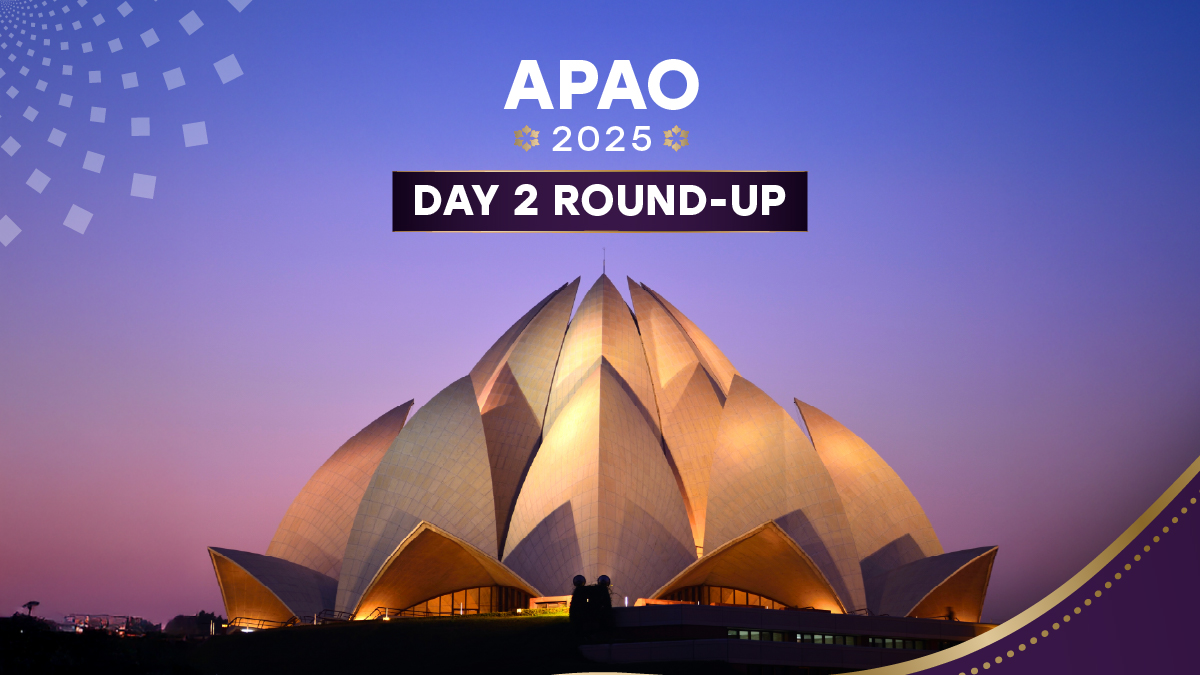Day 2 of the APAO-AIOC 2025 congress showcased groundbreaking advancements in ophthalmology, featuring expert discussions on retinal diseases, personalized LASIK, and innovative treatments for AMD and diabetic retinopathy.
The second day of the 40th Congress of the Asia-Pacific Academy of Ophthalmology (APAO 2025), held in conjunction with the 83rd Annual Conference of the All India Ophthalmological Society (AIOC 2025), reached full momentum.
At the Yashobhoomi Convention Centre in Delhi, a global gathering of almost 12,000 delegates witnessed the brightest minds in ophthalmology shine. From cutting-edge innovations and translational research to breakthroughs in imaging technology, and forefront anterior segment and medical retina breakthroughs, the event spotlighted the latest trends shaping the future of eye care.
Straight from the editor’s desk, here’s your front-row pass to some of Day 2’s standout moments…
The women of retina
The “Retina Talks, Powered by Women: WIO Symposium” showcased influential women leaders in ophthalmology addressing real-world challenges in retinal diseases.
Speakers such as Dr. Choi Mun Chan, Dr. Lia Zaini and Prof. Kyoko Ohno-Matsui shared cutting-edge insights on topics ranging from inherited retinal dystrophies and infectious endophthalmitis to the management of pathologic myopia and diabetic macular edema.
Emphasis was placed on evolving treatments, the role of genetic factors and the importance of personalized care. This symposium highlighted how women ophthalmologists are shaping advancements in retinal disease management and pushing for better outcomes, particularly in underserved regions.
The session offered practical, evidence-based approaches to complex issues, such as the latest trends in anti-VEGF therapies and multimodal imaging in AMD. Experts discussed innovative technologies like CRISPR gene editing and the use of OCT to refine treatment strategies.
Real-world challenges were a central theme, as speakers stressed the need for updated protocols that account for regional differences and resource limitations, ensuring that emerging treatments are accessible and effective in diverse healthcare settings. Read more from our full coverage here.
APAO-AAO joint symposium
In a special APAO symposium co-hosted with the American Academy of Ophthalmology (AAO), experts engaged in spirited debates on pressing retinal issues.
The session featured discussions on topics such as the routine clinical use of optical coherence tomography angiography (OCT-A), optimal surgical approaches for myopic tractional maculopathy and the role of anti-VEGF therapy in neovascular age-related macular degeneration (nAMD).
In one debate, Dr. Muna Bhende advocated for the regular use of OCT-A, highlighting its noninvasive nature and efficiency in monitoring retinal vasculature. Conversely, Dr. Srinivas Sadda questioned its necessity without robust clinical trial data demonstrating improved patient outcomes.
Another discussion contrasted vitrectomy and macular buckle surgeries for myopic tractional maculopathy. Dr. Kyoko Ohno-Matsui supported vitrectomy, citing concerns about potential complications from macular buckles, while Dr. Simon Szeto emphasized the efficacy of macular buckles in improving visual acuity and addressing underlying disease mechanisms. Read more for the full details on these and the other retinal debates contested here.
Customized LASIK
In this session, significant advancements in personalized refractive surgery, particularly through the integration of ray-tracing technology and artificial intelligence (AI) in LASIK procedures were highlighted by experts such as Dr. Pooja Khamar from India.
Dr. Khamar shared promising results from a study comparing ray-tracing guided LASIK to topography-guided LASIK, noting that 72% of eyes treated with ray tracing achieved better than 20/20 vision, compared to only 19% with the traditional method. This approach utilizes a comprehensive 3D model of the eye, incorporating wavefront data, corneal tomography, and biometry to create individualized treatment plans.
Additionally, Dr. Ronald Krueger from the United States presented findings from an FDA trial involving 336 eyes across nine centers, revealing that 92% of patients achieved 20/20 vision or better one year post-operation using ray-tracing guided LASIK.
This technique constructs a “digital twin” of the patient’s eye, allowing for precise customization of the ablation profile. In China, Dr. Chloe Mengdi Chen reported a surge in demand for customized LASIK, attributing its growth to superior post-operative visual quality. These developments underscore a global shift towards more personalized and effective refractive surgery solutions. Read more about lessons from the new generation of refractive surgeries here.
AMD and DR
At the “Translational Research in Age-Related Macular Degeneration (AMD) and Diabetic Retinopathy” symposium, experts presented significant advancements in understanding and treating AMD and diabetic eye diseases.
Asst. Prof. Dr. Sruthi Arepalli discussed the IMAGINE DME study, which revealed that diabetic macular edema (DME) involves complex inflammatory mediators beyond VEGF, highlighting the roles of interleukin-6 (IL-6) and angiopoietin-like protein 4 (ANGPTL4). This suggests potential benefits in tailoring treatments to individual cytokine profiles, especially with emerging therapies like faricimab.
Dr. Kentaro Nishida also analyzed fundus autofluorescence (FAF) patterns in photocoagulation lesions, finding that diffuse FAF patterns correlate with better retinal sensitivity and photoreceptor preservation, leading to the proposal of a photocoagulation index to optimize panretinal photocoagulation (PRP) intensity, particularly in neovascular glaucoma cases. Read more on what’s coming down the lane in retina here.
As we reach the midpoint of the Congress, the excitement is far from over. A wealth of educational masterclasses and hands-on skills transfer sessions are still underway—tailor-made for the next generation of ophthalmologists eager to learn directly from the masters themselves. If you haven’t already, be sure to dive in and make the most of these golden opportunities.
Editor’s Note: Reporting for this story took place during the 40th Congress of the Asia-Pacific Academy of Ophthalmology (APAO 2025), being held in conjunction with the 83rd Annual Conference of the All India Ophthalmological Society (AIOC 2025) from 3-6 April in New Delhi, India.



